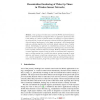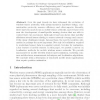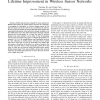263 search results - page 13 / 53 » Mobility improves coverage of sensor networks |
110
click to vote
ICRA
2002
IEEE
15 years 4 months ago
2002
IEEE
— This paper describes decentralized control laws for the coordination of multiple vehicles performing spatially distributed tasks. The control laws are based on a gradient desce...
119
click to vote
EWSN
2007
Springer
15 years 11 months ago
2007
Springer
Duty-cycling in wireless sensor networks (WSNs) has both beneficial effects on network lifetime and negative effects on application performance due to the inability of a sensor to ...
HUC
2009
Springer
15 years 4 months ago
2009
Springer
Over the past decade we have witnessed the evolution of wireless sensor networks, with advancements in hardware design, communication protocols, resource efficiency, and other aspe...
154
click to vote
DMSN
2010
ACM
15 years 28 days ago
2010
ACM
In Mobile Sensor Network (MSN) applications, sensors move to increase the area of coverage and/or to compensate for the failure of other sensors. In such applications, loss or cor...
102
click to vote
ICCCN
2007
IEEE
14 years 12 months ago
2007
IEEE
—Mobile sink has been adopted by many schemes for lifetime improvement in wireless sensor networks. It is necessary to propagate the topological or location changes caused by the...



